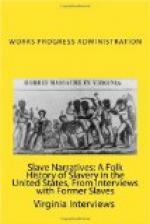“Tell ‘ma’ what you want,” his grandmother put in. Finally, he made up his mind and stood in front of her and said, “Buh—er.” His mother explained, “I’ve done made him some corn bread, but he ain’t got no butter to put on it and he wants you to give him some.”
Sister Morgan sat silent awhile. Then she rose deliberately and went slowly to the ancient ice-box, opened it and took out a tin of butter which she had evidently churned herself in some manner and carefully cut out a small piece and wrapped it neatly and handed it to the little one. After a few amenities, they passed out.
Even with her pitiful and meagre lot, the old lady evidently means to share her bare necessities with others.
The manner of her calculation of her age is interesting. She was six years old when the War was going on. She definitely remembers seeing Sherman’s army and Wheeler’s cavalry after she was six. Since they were in her neighborhood in 1864, she is undoubtedly more than eighty. Eighty-one is a fair estimate.
Interviewer: Samuel S. Taylor
Person interviewed: James Morgan
819
Rice Street, Little Rock, Arkansas
Age: 65
“During the slave time, the pateroles used to go from one plantation to the other hunting Negroes. They would catch them at the door and throw hot ashes in their faces. You could go to another plantation and steal or do anything you wanted if you could manage to get back to your old master’s place. But if you got caught away from your plantation, they would get you. Sometimes a nigger didn’t want to get caught and beat, so he would throw a shovel of hot ashes in the pateroles’ faces and beat it away.
“My daddy used to tell lots of stories about slavery times. He’s been dead forty-three years and my mother has been dead forty-one years—forty-one years this May. I was quite young and lots of the things they told me, I remember, and some of them, I don’t.
“I was born in 1873. That was eight years after the War ended. My father’s name was Aaron and my mother’s name was Rosa. Both of them was in slavery.[TR: sentence lined out.] I got a brother that was a baby in her lap when the Yankee soldiers got after a chicken. The chicken flew up in her lap and they never got that one. The white folks lost it, but the Yankees didn’t get it. I have heard my mother tell all sorts of things. But they just come to me at times. The soldiers would take chickens or anything they could get their hands on—those soldiers would.
“My mother married the first time in slavery. Her first husband was sold in slavery. That is the onliest brother I’m got living now out of ten—that one that was settin’ in her lap when the soldiers come through. He’s in Boydell, Arkansas now. It used to be called Morrell. It is about one hundred twenty-one miles from here, because Dermott is one hundred nine and Boydell is about twelve miles further on. It’s in Nashville[HW:?] County. My brother was a great big old baby in slavery times. He was my mother’s child by her first husband. All the rest of them is dead and he is the onliest one that is living.




